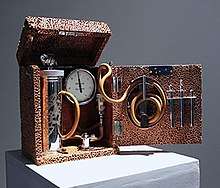Anna Dumitriu
| Anna Dumitriu | |
|---|---|
 Pneumothorax Machine by Anna Dumitriu | |
| Born |
1969 (age 48–49)[1] Brighton, UK |
| Nationality | British |
| Education | University of Brighton |
| Known for | Visual Arts |
| Notable work | The Normal Flora Project The Institute Of Unnecessary Research Trust me, I'm an artist: towards an ethics of art/science collaboration The Romantic Disease |
| Movement | BioArt |
Anna Dumitriu (born 1969) is a visual and performance artist based in Brighton, England, specialising in BioArt. Her installations, interventions and performances use digital, biological and traditional media including bacteria, digital projections and embroidery, working with diverse audiences.[2]
Dumitriu's work is at the forefront of art and science collaborative practice, particularly working with microbiology, robotics, artificial life technology, and art/science ethics. She is involved in public engagement in science, arts in healthcare and the teaching of art/science practice to both art students and medical/science students. She is Artist in Residence on Modernising Medical Microbiology at The University of Oxford, Visiting Research Fellow: Artist in Residence at The University Of Hertfordshire in the Department of Computer Science, and a Visiting Research Fellow: Lead Artist in the Wellcome Trust Brighton and Sussex Centre for Global Health Research at Brighton and Sussex Medical School. She was formerly a Visiting Research Fellow: Artist in Residence in the School of Informatics at Sussex University between 2005 and 2014. She participated in the e-MobiLArt project (EU funded European Mobile Lab for Interactive Artists) and was co-chair of the Arts and Culture Subcommittee of the Alan Turing Centenary. Dumitriu is founder and Director of the Institute of Unnecessary Research and lead artist on the "Trust me, I'm an artist: towards an ethics of art/science collaboration" project working with the Waag Society in Amsterdam and co-author of the book of the same name. She has written extensively on the notion of the "bacterial sublime".
Her work has an international exhibition profile and has been featured in Wired UK Magazine and The Lancet.
Her "Romantic Disease" project explores around historical and contemporary notions of Tuberculosis, whole genome sequencing of bacteria, global health and antimicrobial resistance.
Her most recent artwork focusses on synthetic biology, antibiotic resistance, and sequencing of bacterial DNA. She created "Make Do and Mend" in 2017 which uses the CRISPR gene editing technique of homologous recombination to edit the genome of E. coli bacteria to remove an antibiotic resistance gene and replace it with the phrase "Make Do and Mend" written into its DNA.
In January 2014, Dumitriu told The Guardian: "Art, for me, is a way of investigating the world. In that way, I see no real distinction between art and science at all."][3]
Notes
- ↑ "Anna Dumitriu: Bioart and Bacteria: Biography". normalflora.co.uk.
- ↑ "KT Press". Archived from the original on 2010-08-29. Retrieved 2010-03-21.
- ↑ Barnett, Laura (20 January 2014). "Art in good health: how science and culture mix the best medicine". The Guardian. Retrieved 23 July 2016.